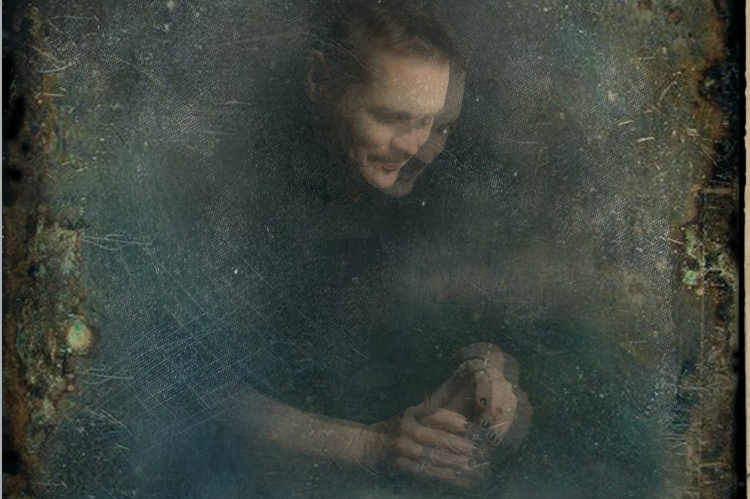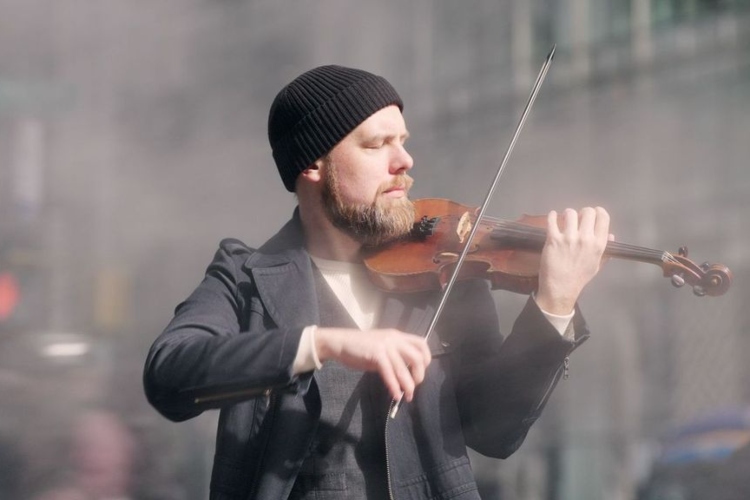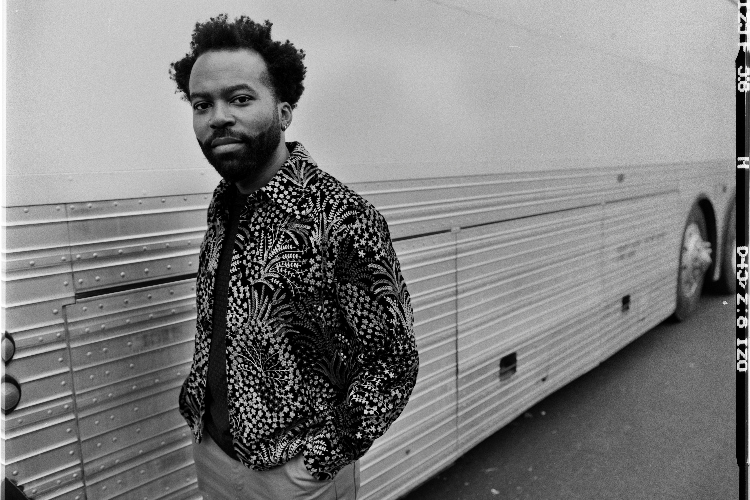Stranger Than Fiction: A Conversation with Trevor Dunn
|
Getting your Trinity Audio player ready...
|
There is much in this world that we do not understand. Phenomena not easily understood by science or human reason. Unexplained mysteries are impossible to distinguish as either shocking reality or mental delusion. As bassist Trevor Dunn writes in the liner notes to Séances (Pyroclastic, 2022), his group Trio-Convulsant’s first release since 2004, “[w]e are the worst portrayers of truth as we have no idea what it is. Everyone is a hypocrite. Everyone is wrong.”
Séances draws its inspiration from the Convulsionnaires of Saint-Médard, a French Catholic sect that still survives in some form today but reached its zenith of prominence in the mid-eighteenth century. The Convulsionnaires claimed its members experienced coprophagia, curative powers, levitation, and milk-vomiting, all allegedly gifts from God. Their detractors claimed they were derived from Satan.
But how do you convert that story into music, particularly instrumental music? Whatever the answer to that question, Dunn and company seem to have done so expertly. It helps that the musicians in the extended ensemble are outsiders in the pop culture zeitgeist. Each of the core members of the trio – Dunn, guitarist Mary Halvorson, and drummer Ches Smith- are important names in modern avant-garde music. But in a Top 40 world that thinks Katy Perry is “high art”, this renders them musical heretics. The members of the chamber quartet – violinist Carla Kihlstedt, bass clarinetist Oscar Noriega, cellist Mariel Roberts, and flutist Anna Webber- are similarly revolutionary. The album is utterly distinct, defying even customs of avant-garde-based improvisation; if there are any. Hues of metal – music regularly accused of dabbling in some dark magic- and chamber music – derivative of the esteemed “classical” music form but intended for hushed and private performances, hidden from the public writ large. While “ Saint-Médard” throws in some country blues for good measure. “Eschatology” lives in the shadow of bop, as if some rendition of Charlie Parker’s “Ornithology” from another, darker, dimension.
The decision to add a chamber quartet, fittingly named “Folie à Quatre” or “Madness for Four”, was a sage one as it adds a new quality to the music. At times the thundering fury of bass and drum and Halvorson’s bent and distorted guitar are met by elegant strings and winds, perhaps opposed to the trio’s activities. At others, the quartet joins in the insanity, even egging the trio to go further. This is most evident in “1733”, a song title representing the year the French government drove the Convulsionnaires underground. In the process, the expanded trio seemingly engages in its own mysterious behaviors- artistic telepathy in a group that has not recorded together for almost two decades and more than doubled its size in the interim.
In our conversation with Dunn, we discuss what brought about Séances, the defiance of conventions, whether our world is a hologram, surrealism, the human subconscious, medical miracles, society’s responses to plagues, and free will.
PostGenre: Séances borrows ideas from jazz, metal, chamber music, and more. In this sense, the album is compatible with your other works as you are often unconstrained by stylistic or genre norms. What are your thoughts on genre?
Trevor Dunn: Well, I don’t think about it that much.
If I’m writing a piece for Trio-Convulsant, I want something that sounds heavier. I use power chords like a rock band. When I originally conceived of Trio-Convulsant years ago, I wanted it to be a jazz trio where I’m composing a lot of counterpoints but one that is also heavy like a rock band. The idea was to both make jazz a little heavier and make heavy rock a little more harmonically complex.
But I don’t necessarily sit down and work to make sure a song crosses genres. It’s all just a part of the palette that I have available. When I’m writing, I just know that all kinds of different musical ideas are available to me. Every part I use is just part of the writing process. Another color to add out of everything.
PG: You mentioned your original conception of Trio-Convulsant. That was about twenty-five years ago. The trio’s last album was eighteen years ago. Why did it take so long to release another one?
TD: It’s funny. Someone else just asked me that and I had to go back and look at my discography on my website. One of the reasons is that I played on over fifty records in that period. Right after the last album [Sister Phantom Owl Fish (Ipecac, 2004)], I toured with the trio but then started getting very active with [John] Zorn.
PG: You are on several of Zorn’s albums. Is there one that particularly stands out to you?
TD: One of my favorites is Six Litanies for Heliogabalus (Tzadik, 2007). It is a variation on the group Moonchild, which is a trio of Joey Baron, Mike Patton, and myself. Eventually, we also added John Medeski on organ. Six Litanies expands Moonchild with three female voices and Ikue Mori on electronics. I love the weird mix of that ensemble and the heavy distortion on that record.
PG: But Zorn records were not the entire reason you kept from recording Trio-Convulsant over the last eighteen years?
TD: Right. I also put out my rock record [White with Foam, MadLove (Ipecac, 2009)], a CD of film music [Four Films (Tzadik, 2008], and one of chamber music [Nocturnes (Tzadik, 2019)]. I’ve been writing all the time. I have also been incredibly active as a performer, though mainly as a sideman. I’m often a sideman. I kind of make my living by learning other people’s music and going on tour with them. It’s always difficult for me to find time for my own music. Leading your own band is the least financially lucrative thing you can do, but it’s also necessary to express yourself.
PG: One thing that is interesting about how much you, Mary [Halvorson], and Ches [Smith] have all developed musically. In 2004, Mary had no albums under her name and now she’s releasing string works and other highly critically acclaimed recordings. Ches released his first album as a leader in 2006 and, since then, has had two very well-received trio albums. Do you think your experiences during that period have changed the communication between the three of you?
TD: All three of us have grown musically. We have each individually become more mature musically, for lack of a better phrase. And that growth has certainly informed what we do when we play with each other. But, at the same time, we have stayed in touch and played with each other and in different ensembles together. We have done a few gigs here and there, just kind of randomly. I think we did something at The Stone here in New York back in 2015. We played trio and some of the old stuff, which we hadn’t done in years.
PG: A little while ago you mentioned your chamber work. Séances developed partly from that project.
TD: Yeah. My original idea was to expand Trio-Convulsant and add a string quartet to it. I wrote a lot of music under that idea but I didn’t like the way it came out. I didn’t like what I wrote. The chamber music record [Nocturnes] allowed me to get that impulse to write for strings out of my system. After releasing that record, I decided to reconfigure the Trio-Convulsant idea and change out some of the strings for wind instruments. I was particularly interested in writing for the alto flute. I’d never written for the flute before and it’s one of my favorite instruments.
PG: Why have you not written for flute before? Just not the right project for it?
TD: It just never came up, I guess. I kind of want to write for every instrument, at some point. I’ve contemplated writing for a brass quintet or doing another chamber music record. I’d also be interested in writing for a brass quintet. I love the idea of traditional forms like a string quartet or piano trio and using them in less conventional ways. I listen to a lot of that kind of music and like the idea of carrying on the tradition in that way.
PG: Is your project writing for a singer-songwriter an extension of that idea as well?
TD: Yes, I’ve been working on that project for way too long. It’s way overdue. It’s another thing that I’ve been chipping away at it whenever I have free time. I listen to a lot of singer-songwriter music. I am a big fan of artists like Elliott Smith and Fiona Apple. My music sounds different from those kinds of things and more like my MadLove record but not quite as rock oriented. There is a different kind of instrumentation stuff but it is still coming from that mold of the singer-songwriter.
PG: And on Séances, you use a quasi-chamber format. The inclusion of strings and winds is reminiscent of classical music. You have indicated in prior interviews that there are certain classical composers you look up to musically, including Webern, Messiaen, Ligeti, and Stravinsky. Are there any composers whose influence you feel may come through the music on Séances?
TD: That’s a good question. One of my favorite composers is Shostakovich. I’ve analyzed some of his music and love what he does harmonically. I love the idea, that you see in Shostakovich’s work, of having tonal centers but greatly messing with them. It is similar to how jazz composers approach tonal centers but Shostakovich was not writing jazz. He was writing music that had these chords that he wanted to analyze. There can be a lot of “wrong” notes in there and I love that. I like to write music that has wrong notes in it and once it’s played twice in a row, the note seems right.
PG: And from the jazz world, another influence for Séances comes from Paul Desmond’s Desmond Blue (RCA Victor, 1962).
TD: There’s such a rich tradition of jazz greats putting out records with strings from Charlie Parker [Charlie Parker with Strings (Mercury, 1950)] to Wes Montgomery [Fusion! Wes Montgomery with Strings (Riverside, 1963)]. Listening to Desmond Blue was the first impetus I had to do something where I added strings to Trio-Convulsant. The idea was to add all of these other instruments and have the whole larger group integrated while still having the trio be the core in a way. Ideally, if I had the funding, I would love to write for Trio-Convulsant and a full orchestra. I don’t know if that will ever happen in my lifetime, but it is a dream.
PG: Of course, there is also the inspiration from the Convulsionnaires of Saint-Médard. How did you discover the story of their sect? It is a seemingly esoteric topic.
TD: The Convulsionnaires are a pretty obscure topic. I first read about it in a book called The Holographic Universe: The Revolutionary Theory of Reality [by Michael Talbot (Harper, 1991)] which is also a somewhat esoteric book. The Holographic Universe discusses studies that have been done on the meaning of consciousness and how humanity understands reality. The book argues that if you think of what we understand as reality as a holograph, many of the inexplicable things in the universe make sense. There are a couple of pages that talk about the Convulsionnaires and I found it fascinating. Since reading about the Convulsionnaires in The Holographic Universe, I read up as much as I could about them.
PG: What was it about that sect that interested you?
TD: For one, the idea of convulsion is a theme within the surrealist art movement of France. Surrealism is the general narrative of Trio-Convulsant. Trio-Convulsant is an effort to write surrealist music if that is even possible. If you go back and look at the origins of surrealism, back to when André Breton coined the term, the art follows many specific formalities. Surrealist art is not just weird for the sake of being weird. I got into surrealism by trying to figure out what people mean when they say an experience is “surreal.” I dove into trying to figure out what that word meant and found that it meant a lot more than just “weird.” The surrealists were very into dream imagery and things happening by chance. They also focused on the juxtaposition of opposites or things you wouldn’t expect, Convulsions tie right into these ideas as they are cases of your attention being arrested and controlled by something that is overwhelmingly beautiful or confusing.
PG: Did you incorporate surrealist artistic practices into the compositions on Seancés? For instance, percussionist Adam Rudolph co-wrote The World at Peace with Yusef Lateef by using a technique surrealist painters called “exquisite corpse.”
TD: Not necessarily. I do like the idea of sometimes leaving things to chance. As a composer, I’m always trying to formalize things and have my little personal systems about writing music. But I do also like the idea of things happening for reasons that can’t be explained and that is something I keep in mind as I’m writing.
Sometimes I do try to write very intuitively almost like a variety of automatic writing, another surrealist concept. With automatic writing, you just write stream-of-consciousness ideas and fo not think about what you are writing. The idea is that you are approaching your subconscious mind and the words and phrases you write come from the imagery formed by your subconscious thought. Sometimes I keep that concept of Automatic writing in mind when I am composing. I might just pick up an instrument and see the first four notes that come out and then base the song around those four notes.
PG: Most of your composing for Séances came to you during the pandemic, correct?
TD: Yeah, I struggled for a while, after I changed the group’s instrumentation, really figure out where this music was going. I wanted to make sure the additional quartet did not just accompany the trio. I also didn’t want the album to be written like a chamber work even if that is where some of the ideas originated. Instead, I imagined that I was writing for a cohesive seven-piece ensemble. It took a while as I was struggling with the concept of the album as I wrote. I kept some of what I wrote before the pandemic and put the rest aside. Maybe I’ll use them for other projects or something. I don’t know.
But yeah, it took quarantine and shutdowns to make me finish the compositions. At that time, I realized I had three of the pieces essentially done and used them to inform the rest of the record. I had written a few things on the slower side and it made me decide I wanted something that has a higher drive and energy to it. That idea is what led to my riff for the first part of the song “1733.” It is almost like a metal riff on cello and bass clarinet.
PG: The Convulsionnaires strongly believed in medical miracles. In 1731 alone, they announced they had cured a variety of ailments including paralysis, cancer, and blindness. Do you think it is a coincidence you finished an album about the group during the middle of the pandemic when so many people were falling ill and even dying?
TD: I’m not sure. Maybe it is a coincidence, but maybe it is something in my subconscious. But it was funny because, during the beginning of the pandemic, I re-read [Albert] Camus’ The Plague (Gallimard, 1947). I last read it many years ago, probably while I was in college. As I re-read it, I was struck by how relevant it was and how human behavior hasn’t changed very much since the 1940s. I am sure that the frustration I felt about how little people changed informed the music on the album.
PG: The Convulsionnaires were also an offshoot of the Jansenist movement, which its critics alleged did not believe in free will. Did you see a parallel between the absence of free will and being deprived of some ability to act due to quarantines and shutdowns?
TD: Yeah, yeah. The whole battle in the Catholic church between the Jansenists and their rivals, the Molinists, was basically caused by one sect believing in free will and the other not believing in it. They each kept accusing each other of being heretics. And when people had convulsions, the argument became one over whether they were having convulsions because they were heretics and evil or if it is actual religious ecstasy. I don’t know. I find all that totally interesting. Humans are so weird, man. You can’t make this stuff up. The truth is stranger than fiction, you know?




2 thoughts on “Stranger Than Fiction: A Conversation with Trevor Dunn”